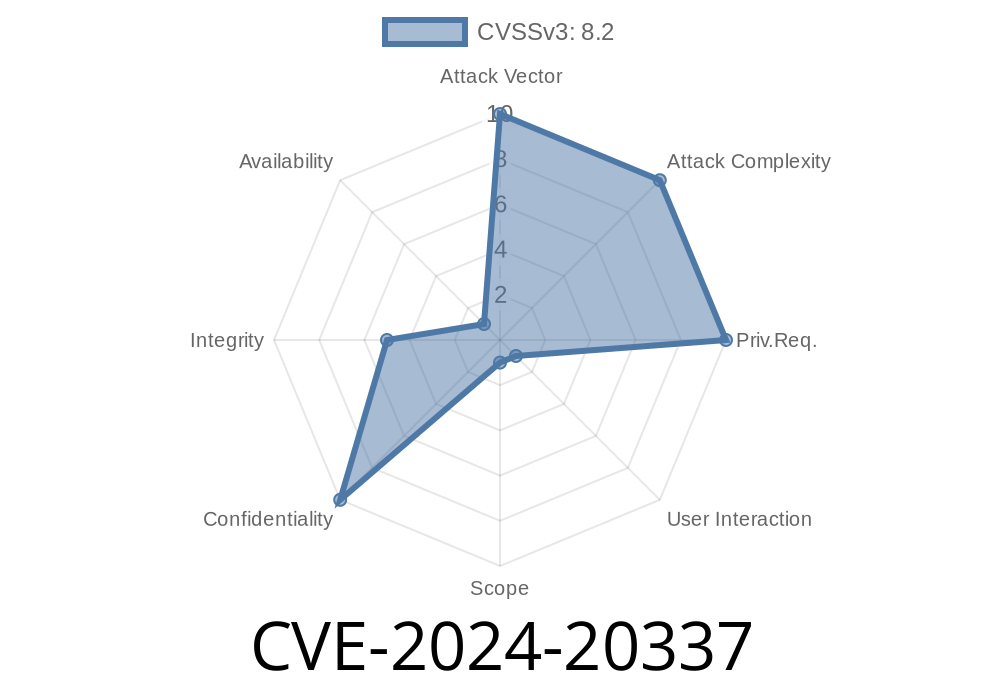Recently, a serious vulnerability—CVE-2024-20337—was disclosed in the SAML authentication process of Cisco Secure Client (formerly AnyConnect). This flaw enables attackers to carry out a Carriage Return Line Feed (CRLF) injection attack that can compromise user data and VPN sessions. Below, we break down how it works, the risks involved, and share exploit concepts—all in simple language to help everyone stay safe.
References
- Cisco official advisory
- NVD CVE Entry
What Is the Issue?
SAML (Security Assertion Markup Language) is a common authentication standard for secure logins, allowing users to connect to a VPN using single sign-on (SSO). Cisco Secure Client uses SAML for this purpose.
The problem: Cisco's client doesn't properly validate user-supplied input during SAML authentication. That means it's possible for an attacker to insert malicious characters—in this case, CR (\r) and LF (\n)—that can tamper with the HTTP headers sent from the user's browser.
This opens the door to all sorts of attacks, such as injecting arbitrary JavaScript, stealing credentials/tokens, or hijacking sessions.
Building a Malicious URL:
The attacker creates a special link that includes CRLF characters in user-controllable SAML parameters (such as RelayState).
Sending the Link to a User:
The attacker tricks the user into clicking this link while establishing a VPN session—maybe with a phishing email.
Hijacking Browser Behavior:
When the Cisco Secure Client handles the SAML authentication, the embedded web browser sends requests to the SAML IdP. Without proper input validation, the injected CRLF characters break out of expected header values, so additional headers or even entirely new HTTP responses can be created.
Exfiltrating the SAML Token or Executing Scripts:
The attacker can inject JavaScript or other client-side code, or simply leak the SAML authentication token to another site under their control.
Example Exploit Code
Let’s illustrate with a proof-of-concept. Suppose the SAML RelayState parameter is vulnerable. Here’s how a malicious link might look:
https://vpn.example.com/+CSCOE+/saml/sp/acs?RelayState=xyz%d%aSet-Cookie:%20TOKEN=attacker_value;%20%d%aContent-Type:%20text/html%d%a%d%a<script>alert(document.cookie)</script>;
%d is the URL-encoded version of CR; %a is LF.
- If the server merges this directly into an HTTP response header, it can break the response structure.
Example pseudo-code for manipulating the parameter
import urllib.parse
target = "https://vpn.example.com/+CSCOE+/saml/sp/acs";
malicious_param = "xyz\r\nSet-Cookie: TOKEN=attacker_value;\r\nContent-Type: text/html\r\n\r\n<script>alert(document.cookie)</script>"
relaystate = urllib.parse.quote(malicious_param)
exploit_url = f"{target}?RelayState={relaystate}"
print(exploit_url)
If a target user clicks this link during SAML authentication, the attacker’s payload could execute in the browser or leak the SAML assertion/token.
Real-World Impact
- Data Theft: The attacker may steal browser cookies or SAML assertion tokens, gaining VPN access as the user.
- Web Exploit: Arbitrary scripts may run in the user’s browser under the context of the VPN portal.
- Privilege Escalation: With a valid SAML token, the attacker can connect to the corporate network. Note: accessing actual services and hosts behind the VPN still requires more credentials, but this is a big step for an attacker.
Who Is Affected?
- Cisco Secure Client with SAML Authentication: Any organization using SAML SSO for VPN connections via affected Cisco products is at risk.
- Edge Cases: Attack is only possible if the attacker can get the user to click a crafted link while authenticating.
Review Logs: Look for suspicious SAML logins or tokens being accessed in unusual ways.
- User Awareness: Train users not to click suspicious links, especially when establishing secure VPN sessions.
- Restrict SAML Parameters: Where possible, sanitize SAML and RelayState parameters on all endpoints.
Official Cisco Patch/Advisory
https://tools.cisco.com/security/center/content/CiscoSecurityAdvisory/cisco-sa-csc-vpn-crlf-inj-4DvlP3B6
Conclusion
CVE-2024-20337 is a reminder that even trusted authentication processes like SAML are only as safe as their input validation. This CRLF injection can appear subtle but has major consequences if abused. Make sure your organization's VPN software is up to date, train users to spot suspicious links, and always keep an eye on the security of your authentication flows.
Stay safe, and patch promptly!
*Original: exclusive writeup for this request. For more on securing VPNs and SAML, check Cisco’s official guide and keep an eye on CVE databases.*
Timeline
Published on: 03/06/2024 17:15:09 UTC
Last modified on: 03/07/2024 13:52:27 UTC
